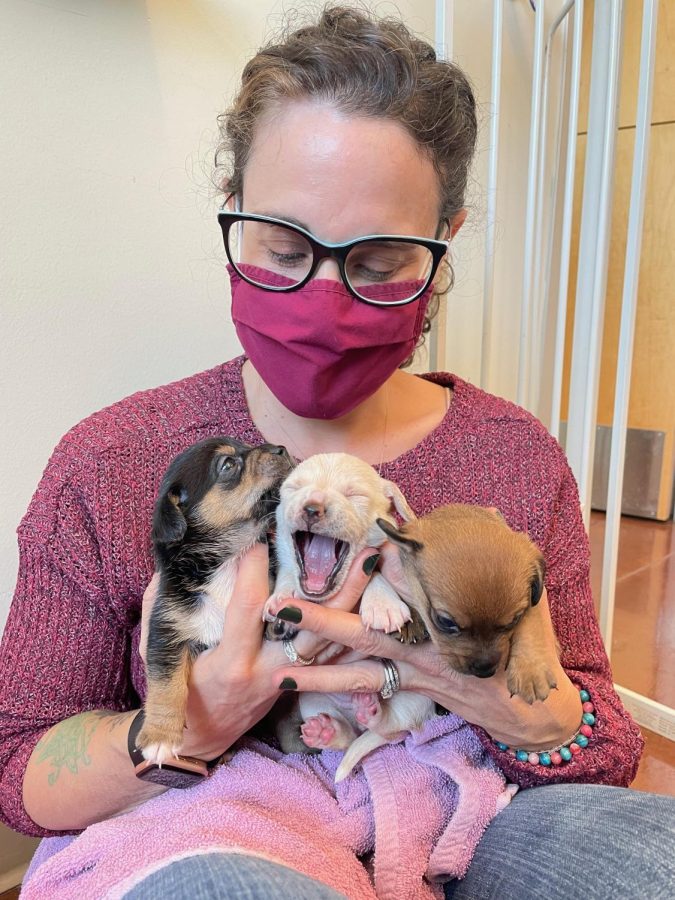So you wanna be an animal shelter worker?
Provided by Dr. Sue McNeill-Bindon
Dr. Sue McNeill-Bindon takes a walk with her rescue dog Honey. McNeill-Bindon found the dog 12 years ago at the dump and nursed her back to health.
October 10, 2021
When Dr. Sue McNeill-Bindon first found her dog Honey at the dump, the dog was sick and unfamiliar to humans and interaction. It took months before anyone could touch her, making it difficult to treat her since she was struggling physically. McNeill-Bindon mentions that now, 12 years later, her dog was able to make it out of her original harsh living conditions into a new home.
Similar life changing encounters with animals like this have motivated McNeill-Bindon to join the Humane Society Silicon Valley as an animal shelter worker to dedicate much time and energy towards caring for them and honoring the Humane Society’s mission, working there for 2 and a half years now. Established in 1929, the organization holds a variety of programs to save and enhance the lives of domesticated animals.
One of their more recent programs, Community Development, involves initiatives such as a pet pantry, allowing people suffering from homelessness or food insecurity to provide nutritious food for their pets. In addition, they host monthly spay and neuter and wellness clinics, providing free healthcare to the pets of families dealing with financial insecurity to maximize the number of healthy and safe animals. The Humane Society also organizes exchanges with shelter partners around the community, such as San Jose Animal Care Center and Silicon Valley Animal Care Authority, and takes in animals that otherwise would have been euthanized due to a lack of space in other shelters.
Unfortunately, the coronavirus pandemic hit the Humane Society hard last year. Systems they had in place to uphold their mission statement needed to be completely changed in a short period of time to adjust to the new obstacle.
“When shelter in place started, all of the animals who were currently available on the adoption floor had to go into foster care because we didn’t have enough staff on site to provide round-the-clock care for a whole shelter full of animals,” McNeill-Bindon said. “Our emphasis shifted at the very beginning of the pandemic to seeing how many foster families we could bring on to care for all of the animals coming in.”
Along with the increase in pace surrounding animal fostering, the shelter experienced a lack of volunteers after shelter-in-place mandates. The strict building capacities, as well as older volunteers with compromised immune systems uncomfortable with volunteering in person, led to a decrease in overall volunteer participation.
“We had to try to find other ways to keep the people who are connected to us feeling invested in our work when they couldn’t physically come in,” McNeill-Bindon said. “Our fundraising dropped and we could not hold our big fundraising events. There was more work to do and less money and people coming in to do it.”
In response, McNeill-Bindon and her team worked quickly to adapt the Humane Society and its programs for offsite success, such as through increasing the accessibility of the pet pantry, bringing in more foster families and evolving the adoption process to a structured online experience.
According to McNeill-Bindon, the pet pantry grew from around 35 to 40 clients to around 400, demonstrating an increase of almost 400% during the pandemic. The establishment of a delivery service largely contributed to this astronomical growth and expansion, also ensuring that families uncomfortable with or unable to come onsite during the pandemic could still provide care for their pets.
And as the Humane Society Silicon Valley and similar animal shelters faced numerous difficulties due to the unforeseen pandemic, dedicated and passionate volunteers and workers such as McNeill-Bindon worked tirelessly to help as many animals as possible. She recounts that the feeling after successfully helping an animal is what keeps her going. Recently, the shelter cared for dog bottle babies whose mom had fallen sick, and she recounts the rewarding feeling as the pups matured, transitioning from bottle feeding to solid food.
“Every day you feel like you’ve done something good; even if you’ve had a super [bad] day, you’re part of a network of people who care about other people and other animals,” McNeill-Bindon said. “You’re helping to save lives, and I don’t think there is a better thing that you can do that pays you as much as you pay for it.”


















![“[Building nerf blasters] became this outlet of creativity for me that hasn't been matched by anything else. The process [of] making a build complete to your desire is such a painstakingly difficult process, but I've had to learn from [the skills needed from] soldering to proper painting. There's so many different options for everything, if you think about it, it exists. The best part is [that] if it doesn't exist, you can build it yourself," Ishaan Parate said.](https://harkeraquila.com/wp-content/uploads/2022/08/DSC_8149-900x604.jpg)




![“When I came into high school, I was ready to be a follower. But DECA was a game changer for me. It helped me overcome my fear of public speaking, and it's played such a major role in who I've become today. To be able to successfully lead a chapter of 150 students, an officer team and be one of the upperclassmen I once really admired is something I'm [really] proud of,” Anvitha Tummala ('21) said.](https://harkeraquila.com/wp-content/uploads/2021/07/Screen-Shot-2021-07-25-at-9.50.05-AM-900x594.png)







![“I think getting up in the morning and having a sense of purpose [is exciting]. I think without a certain amount of drive, life is kind of obsolete and mundane, and I think having that every single day is what makes each day unique and kind of makes life exciting,” Neymika Jain (12) said.](https://harkeraquila.com/wp-content/uploads/2017/06/Screen-Shot-2017-06-03-at-4.54.16-PM.png)








![“My slogan is ‘slow feet, don’t eat, and I’m hungry.’ You need to run fast to get where you are–you aren't going to get those championships if you aren't fast,” Angel Cervantes (12) said. “I want to do well in school on my tests and in track and win championships for my team. I live by that, [and] I can do that anywhere: in the classroom or on the field.”](https://harkeraquila.com/wp-content/uploads/2018/06/DSC5146-900x601.jpg)
![“[Volleyball has] taught me how to fall correctly, and another thing it taught is that you don’t have to be the best at something to be good at it. If you just hit the ball in a smart way, then it still scores points and you’re good at it. You could be a background player and still make a much bigger impact on the team than you would think,” Anya Gert (’20) said.](https://harkeraquila.com/wp-content/uploads/2020/06/AnnaGert_JinTuan_HoHPhotoEdited-600x900.jpeg)

![“I'm not nearly there yet, but [my confidence has] definitely been getting better since I was pretty shy and timid coming into Harker my freshman year. I know that there's a lot of people that are really confident in what they do, and I really admire them. Everyone's so driven and that has really pushed me to kind of try to find my own place in high school and be more confident,” Alyssa Huang (’20) said.](https://harkeraquila.com/wp-content/uploads/2020/06/AlyssaHuang_EmilyChen_HoHPhoto-900x749.jpeg)












